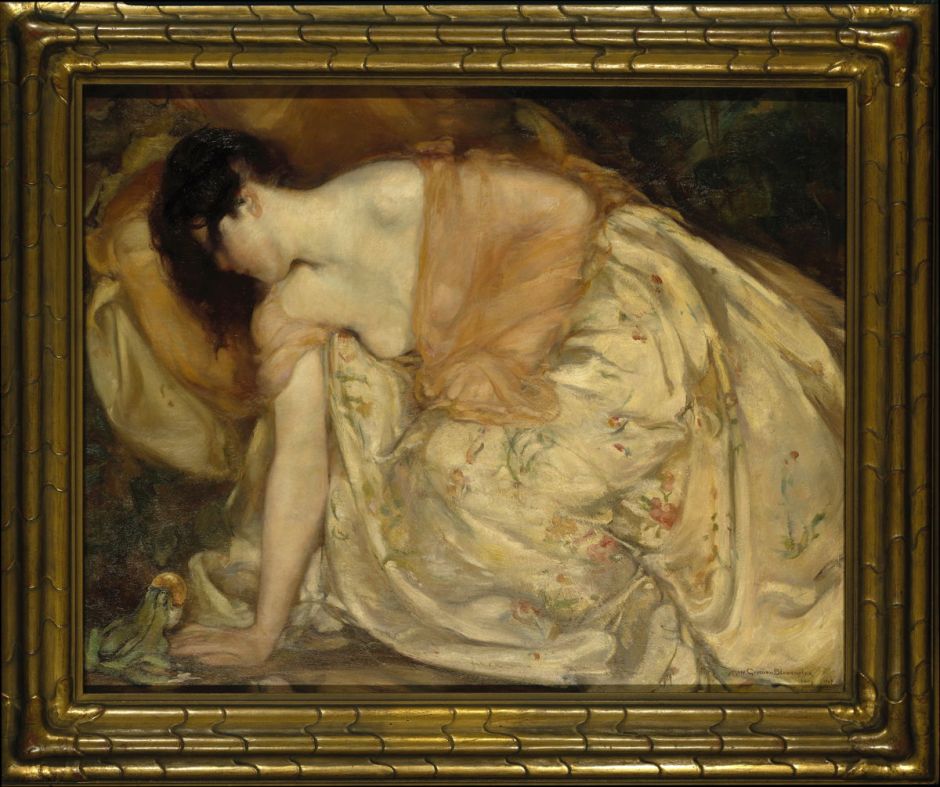The first of these two articles considered the classical myth of Latona, who transformed the obstructive Lycians into frogs, and the sorceress Medea, who was accompanied by toads. Today I look for frogs in paintings of folk stories, and a few other works that defy classification.
The popular children’s story of the Frog Prince, which appears in many variants, is usually considered to be a fairy tale, and is the first in the major collection published by the Brothers Grimm. Its origins are much older, and it’s now thought to date back to a folk story or legend first cited in classical Roman times.
The version recorded by the Grimms has a spoiled princess drop a golden ball into a pond. This elicits the appearance of a frog, who holds the ball in his mouth. The princess reluctantly makes friends with the frog, who is eventually transformed into a handsome prince when the spell binding him in the form of a frog is broken. Recent retelling of this story often makes the princess’s kiss the event that breaks the spell, although in the Grimms’ version the princess throws the frog against a wall in disgust, which seems a bit harsh.

Marianne Stokes’ delightful painting of The Frog Prince from about 1890 shows an incredulous young princess listening to the talking frog, whose real identity, and the outcome of the story, is made obvious by his crown.

In Kolo Moser’s dark Frog Prince from about 1895, the frog wears a small crown, and presents the princess with the golden ball she had lost in the pond.

Moser revisited the motif in about 1905 for this charming bookplate designed for Adele Bloch-Bauer, the heiress whose portraits were famously painted by Gustav Klimt.

Mary Sheppard Greene’s account of The Princess and the Frog from 1909 is firmly rooted in the Grimms’ version, with the frog still holding her golden ball in its mouth, and no clue of its resolution.
Frogs also star in several European fables.

Pierre Bonnard’s exquisite three-panelled Japoniste screen of The Stork and Four Frogs was painted at the outset of his career, in about 1889. Its story is contrastingly European, and based on one of Aesop’s fables retold by Jean de La Fontaine’s The Frogs who Demand a King.
The version retold by La Fontaine centres on a colony of frogs, who ask Jupiter for a king. The god’s first response to their request is a laid-back and gentle leader, whom the frogs reject as being too weak to rule them. Jupiter’s second attempt is a crane, who kills and eats the frogs for his pleasure. When the frogs complain to Jupiter, he then responds that they had better be happy with what they have got this time, or they could be given something even worse.
Bonnard’s panel is traditionally interpreted not as showing the evil crane of the second attempt, but the first and gentle ruler.
Although uncommon in other paintings, frogs and toads do appear elsewhere.

A few are to be found among Hieronymus Bosch’s strange visions. The left panel of his triptych The Temptation of Saint Anthony in Lisbon, dated to about 1500-10, shows Saint Anthony being assisted by three others, as he crosses a small wooden bridge, in a state of complete exhaustion, perhaps after being beaten unconscious by the devil. In the countryside around that group are weird human and portmanteau animal figures. On the left is an invented bird-like creature with a long straight bill, which is swallowing a whole frog.

Cornelis van Haarlem showed this cavalcade of animals not in the creation, but with The Fall of Man (1592), whose many different species are seen in the Garden of Eden. These include a monkey, dog, fox, sheep, cat, snail and frog.

A small frog stands proudly in the foreground of Paulus Potter’s first masterpiece, which continued to be ranked alongside Rembrandt’s finest for the next couple of centuries, The Bull (also widely known as The Young Bull) from 1647. Originally intended just to be a portrait of the central bull, Potter enlarged the canvas to accommodate (from the left) a ram, lamb, ewe, herdsman, cow, and above them a bird of prey, possibly a buzzard. Beyond them are more cattle in the meadows, receding to the church of Rijswijk, between Delft and The Hague. I don’t know whether the frog was intended as a signature device here.

Finally, Gustave Doré’s strange painting Between Sky and Earth from 1862, also features a frog in the foreground. The viewer is high above the fields outside the artist’s native Strasbourg, where several small groups are flying kites. The kite shown at the upper left has just been penetrated by a flying bird. Another unseen kite, off the top of the canvas, has a traditional tail, at the end of which a very anxious frog is tied to it by a hindleg. However, a stork appears to have designs on seizing the opportunity to eat the frog, and is approaching from behind, its bill wide open and ready for the meal.
This could be an allegory, of course, but is probably a humorous depiction of kite-flying at the time, when people were still curious as to what happened to living creatures as they ascended higher in the atmosphere.

